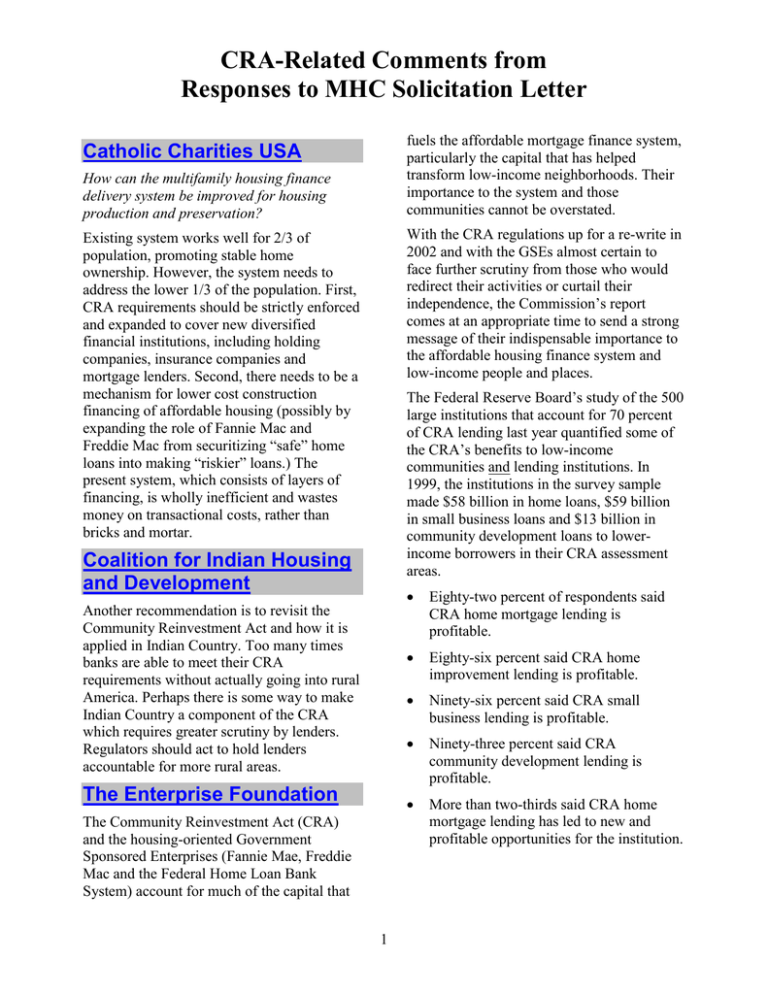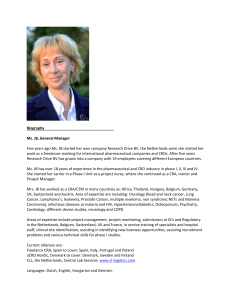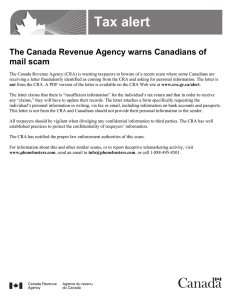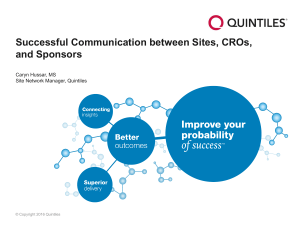CRA-Related Comments from Responses to MHC Solicitation Letter Catholic Charities USA
advertisement

CRA-Related Comments from Responses to MHC Solicitation Letter fuels the affordable mortgage finance system, particularly the capital that has helped transform low-income neighborhoods. Their importance to the system and those communities cannot be overstated. Catholic Charities USA How can the multifamily housing finance delivery system be improved for housing production and preservation? With the CRA regulations up for a re-write in 2002 and with the GSEs almost certain to face further scrutiny from those who would redirect their activities or curtail their independence, the Commission’s report comes at an appropriate time to send a strong message of their indispensable importance to the affordable housing finance system and low-income people and places. Existing system works well for 2/3 of population, promoting stable home ownership. However, the system needs to address the lower 1/3 of the population. First, CRA requirements should be strictly enforced and expanded to cover new diversified financial institutions, including holding companies, insurance companies and mortgage lenders. Second, there needs to be a mechanism for lower cost construction financing of affordable housing (possibly by expanding the role of Fannie Mac and Freddie Mac from securitizing “safe” home loans into making “riskier” loans.) The present system, which consists of layers of financing, is wholly inefficient and wastes money on transactional costs, rather than bricks and mortar. The Federal Reserve Board’s study of the 500 large institutions that account for 70 percent of CRA lending last year quantified some of the CRA’s benefits to low-income communities and lending institutions. In 1999, the institutions in the survey sample made $58 billion in home loans, $59 billion in small business loans and $13 billion in community development loans to lowerincome borrowers in their CRA assessment areas. Coalition for Indian Housing and Development Another recommendation is to revisit the Community Reinvestment Act and how it is applied in Indian Country. Too many times banks are able to meet their CRA requirements without actually going into rural America. Perhaps there is some way to make Indian Country a component of the CRA which requires greater scrutiny by lenders. Regulators should act to hold lenders accountable for more rural areas. The Enterprise Foundation The Community Reinvestment Act (CRA) and the housing-oriented Government Sponsored Enterprises (Fannie Mae, Freddie Mac and the Federal Home Loan Bank System) account for much of the capital that 1 Eighty-two percent of respondents said CRA home mortgage lending is profitable. Eighty-six percent said CRA home improvement lending is profitable. Ninety-six percent said CRA small business lending is profitable. Ninety-three percent said CRA community development lending is profitable. More than two-thirds said CRA home mortgage lending has led to new and profitable opportunities for the institution. CRA-Related Comments from Responses to MHC Solicitation Letter HAC believes that the Community Reinvestment Act (CRA), which has increased credit availability and community lending opportunities in many low-income urban neighborhoods, should be extended to smaller banks so that its reach expands into rural America. About two-thirds reported additional benefits from such lending, such as strengthening communities. The report also found that loss rates for the lenders in the survey were quite low; for example, the median difference in “chargeoff” rates between CRA home mortgage loans and all such loans was zero. McAuley Institute Other recent research has shown that lenders with CRA agreements “were significantly more responsive than other lenders to the credit needs of low-income and minority households and census tracts.” While financial institutions have become visible partners in community development, insurance companies have not and remain an obstacle to housing development in lowincome, minority communities. The Commission should encourage federal policies similar to the Community Reinvestment Act and HMDA so that insurance redlining does not hinder the upgrading and production of affordable housing for all Americans. The housing-oriented Government Sponsored Enterprises (GSEs) are equally important to the affordable mortgage finance system. Under the new Affordable Housing Goal requirements, Fannie Mae and Freddie Mac will acquire $2.5 trillion in mortgages for 28 million low- and moderate-income families over the next seven years. The Federal Home Loan Bank System’s Affordable Housing Program has provided financing to help develop nearly 274,000 affordable homes and apartments for low- and moderate-income households. National Neighborhood Housing Network In recent years, financial services have been overhauled in the market and subsequently in Congress. The Glass-Steagall Act was repealed with the passage into law of the Financial Services Modernization Act November 1999, also known as the GrammLeach-Bliley Act. This action has had major implications for non-profit housing organizations as the market for banks, securities firms, insurance companies, and others dramatically changed. The Financial Services Modernization Act facilitates affiliations among financial services providers, allowing companies to participate in markets from which they were previously excluded. It also limits the checks and balances on financial transactions, and reduces the power of important laws like the Community Reinvestment Act. We encourage the Commission to highlight the importance of the CRA and the housing GSEs to the affordable mortgage finance system and to caution Congress against any changes to them that would harm their ability to provide capital to low-income people and communities. Housing Assistance Council Rural households have a harder time than their urban counterparts in finding mortgage credit, and they generally pay more for the credit they do receive: approximately 17 percent of all nonmetro homeowners with a mortgage agreed to interest rates of 10 percent or more in order to get their loans. 2 CRA-Related Comments from Responses to MHC Solicitation Letter The Community Reinvestment Act (CRA) was passed in 1977 in response to publiclyinsured banks’ and thrifts’ “redlining” of certain communities, thereby limiting these communities’ access to credit and capital. With CRA, banks were barred from withholding services from communities based on income and race. Many more communities gained access to credit, subsequently improving the market and enabling these communities to build their equity through home ownership and other property. In 1999, Federal Reserve Governor Edward Gramlich estimated that CRA-related home, small business, and economic development loans totaled $117 billion annually. ability to serve the housing market should be put to the same sorts of tests to assure that their practices are non-discriminatory and are encouraging of access to the market. The tests would also prevent predatory lending practices, which will be discussed more in the next section. Suggestion: Support the modernization of the Community Reinvestment Act and uniform evaluations of financial services providers. Some members of Congress have already shown their support for the modernization of the Community Reinvestment Act. The Community Reinvestment Modernization Act of 2001 (H.R.865), introduced by Representatives Thomas Barrett and Luis Gutierrez already has 36 sponsors. The act was proposed “to enhance the availability of capital and credit for all citizens and communities [and] to ensure that community reinvestment keeps pace as banks, securities firms, and other financial service providers become affiliates as a result of the enactment of the Gramm-Leach-Bliley Act [...].” CRA has been a critical tool for NeighborWorks® organizations by enabling them to develop creative partnerships that have been beneficial to banks, the organizations themselves, and low-income communities. CRA has been a significant impetus for bank involvement in community revitalization efforts, and has changed neighborhoods. More minorities and lowincome households are able to get the credit they need to own their own homes. We ask the Millennial Housing Commission to support legislation that would modernize the Community Reinvestment Act and increase access to credit for low-income and minority households. The Financial Modernization Act did not change the fact that banks must still follow CRA guidelines; however, the legislation allows other companies that are not obligated to follow CRA regulations to participate in the housing market. In addition, the legislation allows more fluid affiliations between banks and these other companies, enabling banks to profit through their affiliates for the very practices that they themselves are unable to perform. Neighborhood Reinvestment Corporation So often, discussions about housing finance move directly to federal programs, and yet the bulk of funds supporting affordable single family and multifamily housing comes from the conventional money markets – although frequently supported by various gapfinancing approaches provided through federal programs. The recognition that conventional sources of capital in support of affordable housing continue to be enormously The National Neighborhood Housing Network supports financial modernization across the board and believes CRA should be modernized to keep up with the field. In addition, all service providers who have the 3 CRA-Related Comments from Responses to MHC Solicitation Letter important, leads us to support any and all efforts that encourage the flow of appropriately priced private capital to meet the needs of underserved families and communities. The Community Reinvestment Act represents the nation’s single most important vehicle for encouraging the flow of private capital to underserved families and communities. Currently before the House is “The Community Reinvestment Modernization Act of 2001” (H.R. 865). Although Neighborhood Reinvestment has not studied this specific proposal, we support its stated objective: “to enhance the availability of capital and credit for all citizens and communities [and] to ensure that community reinvestment keeps pace as banks, securities firms, and other financial service providers become affiliates as a result of the enactment of the Gramm-Leach-Bliley Act . . .” It should be noted that bank participation in the acquisition and rehabilitation financing that I have mentioned in these comments has occurred via programs created as part of the banks’ response to the requirements of the Community Reinvestment Act (CRA). Maintenance and expansion of CRA to regulate the mega-financial institutions, whose role in finance is rapidly growing, is necessary to encourage the availability of private resources. Additionally, support for the Community Development Financial Institutions program should be maintained; this program has allowed the recreation of new partnerships between community based financial organizations and the private sector. University Neighborhood Housing Program Community Development Block Grants, HOME funds, Low Income Weatherization funds, community reinvestment loans from banks (sometimes in coordination with the aforementioned grants and low-interest government loans) have all been key sources of financing for the stabilization and preservation of this kind of housing. Continued, and expanded, funding is necessary to support such efforts. The creation of a National Housing Trust Fund would certainly provide much-needed resources. … Reducing exit tax liability increases the likelihood that tax credit projects will stay affordable and healthy economically, remain in community control and need less financial support in the future. 4





